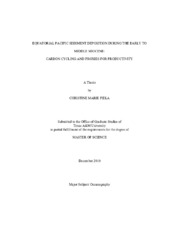| dc.description.abstract | The equatorial Pacific is a major region of biological production in the world oceans and an important part of the global carbon cycle. Changes in climate during the Cenozoic (65 Ma to present) have impacted the carbon cycle, and it is important to assess these impacts. This study focuses on the primary productivity of the equatorial Pacific during the early to middle Miocene (24 - 12 Ma) as recorded by Deep Sea Drilling Project (DSDP) Site 574, and investigates the sedimentary components potentially linked to productivity: bio-Ba, bio-SiO₂, Corg, CaCO₃, and uranium, as well as detrital thorium to estimate clay-bound barium. Within this time frame the plate beneath Site 574 traveled northwesterly across the equator and allows a unique opportunity to monitor changes in productivity and the carbon cycle in this region. It is difficult to determine directly primary productivity from the sedimentary record because the preservation of different proxies for this parameter - Corg, bio-CaCO₃, and bio-SiO₂, can be highly variable. The variability has many causes, including nutrient recycling in the water column and the depth of the carbonate compensation depth (CCD), which prevents the preservation and ultimate burial of plankton debris at the seafloor. To interpret the production versus deposition rates during the early and middle Miocene, proxies were used in conjunction with direct measurements of biogenic remains. By determining the concentrations of biogenically produced barium (bio-Ba), which is less affected by degradation, it is evident that the mass of Corg produced was much greater than that preserved in the sediments. We observed higher deposition of bio-Ba and bio- SiO₂ as the site was transported over the equatorial divergence by plate tectonics, as expected. In contrast, CaCO₃, accumulation was low in the divergence region, and coincides with a dissolution event known from other site studies in the equatorial Pacific. The pattern of uranium deposition resembles CaCO₃ and Corg, and average U concentrations suggest that it was primarily deposited as a trace element in the shell material of biogenic carbonate. Corg also resembles CaCO₃ and appears to represent primarily a dissolution signal. Total uranium analysis proved to be a useful proxy for Corg and CaCO₃ preservation, and analysis of detrital thorium (²³²Th) concentration suggests very limited terrigenous clay input. Comparison of the different proxies reveals carbonate preservation events, changes in Corg preservation, and changes in deposition as DSDP Site 574 migrated northwesterly across the equator. | en |


